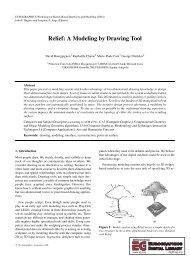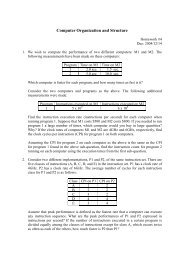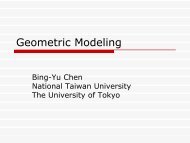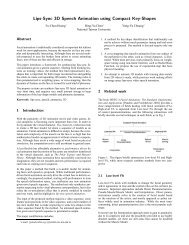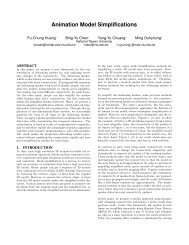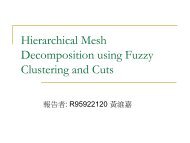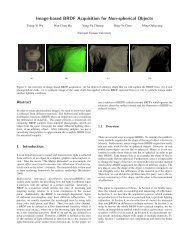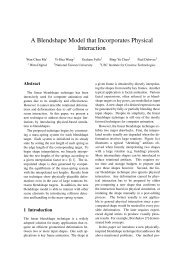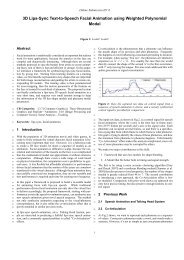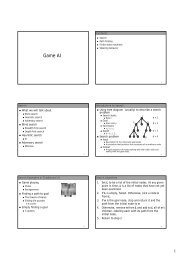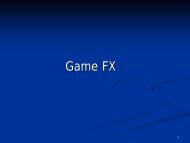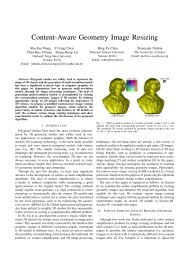Geometry Images
Geometry Images
Geometry Images
Create successful ePaper yourself
Turn your PDF publications into a flip-book with our unique Google optimized e-Paper software.
<strong>Geometry</strong> <strong>Images</strong><br />
Xianfeng Gu<br />
Harvard University<br />
Steven Gortler<br />
Harvard University<br />
Hugues Hoppe<br />
Microsoft Research
Irregular meshes<br />
Vertex 1 x 1 y 1 z 1<br />
Vertex 2 x 2 y 2 z 2<br />
…<br />
Face 2 1 3<br />
Face 4 2 3<br />
…
Texture mapping<br />
Vertex 1 x 1 y 1 z 1<br />
s 1 t 1<br />
Vertex 2 x 2 y 2 z 2<br />
s 2 t 2<br />
…<br />
Face 2 1 3<br />
Face 4 2 3<br />
…<br />
normal map
Remeshing<br />
[Eck et al 1995]<br />
[Lee et al 1998]<br />
[Khodakovsky 2000]<br />
[Guskov et al 2000]<br />
…<br />
irregular vertex indices<br />
only semi-regular
<strong>Geometry</strong> Image
<strong>Geometry</strong> Image<br />
completely regular sampling
<strong>Geometry</strong> Image<br />
►Advantages:<br />
• Other surface attributes, such as normal and<br />
colors, are sharing the same domain as the<br />
geometry<br />
• Parameterization itself is implicit - Texture<br />
coordinates are absent.
Basic idea<br />
cut<br />
parametrize
Basic idea<br />
cut<br />
sample
Basic idea<br />
cut<br />
store<br />
render<br />
[r,g,b] = [x,y,z]
Creation of <strong>Geometry</strong> <strong>Images</strong><br />
Overview<br />
1. Find a good cut ρ<br />
2. Parameterize according to opened cut ρ’
Parameterization<br />
► Assume that we are given a good cut ρ,<br />
we do 2 things:<br />
1. Boundary parameterization<br />
Fix a mapping between the opened cut ρ’<br />
and the boundary of the unit square D.<br />
2. Interior parameterization<br />
Solve for a map of M’ onto D that is<br />
consistent with these boundary conditions.
Boundary Parameterization<br />
a<br />
a’<br />
a’<br />
Constraints:<br />
• cut-path mates identical length<br />
• endpoints at grid points<br />
• No triangle in M’ can have its all vertices<br />
mapped to one of the four sides of the<br />
square.<br />
• Break any edge that spans one of the four<br />
corners of D.<br />
a<br />
no cracks<br />
Avoid<br />
degeneracies
Interior Parameterization<br />
►L2 Geometric-stretch metric<br />
• Simplified M’ into progressive mesh.<br />
[Sander et al 2001]<br />
[Sander et al 2002]<br />
• From base mesh, apply vertex splits to successfully<br />
refine the mesh.<br />
• For each inserted vertex, minimize stretch using a local,<br />
non-linear optimization algorithm.
Stretch parametrization<br />
Previous metrics<br />
(Floater, harmonic, uniform, …)
Cutting<br />
sphere in 3D<br />
2D surface disk
Cutting<br />
sphere in 3D<br />
2D surface disk<br />
► Genus-0 surface any tree of edges
Cutting<br />
torus (genus 1)<br />
► Genus-g surface 2g generator loops minimum
Surface cutting algorithm<br />
(1) Find topologically-sufficient cut:<br />
2g loops<br />
[Dey and Schipper 1995]<br />
[Erickson and Har-Peled 2002]<br />
(2) Allow better parametrization:<br />
additional cut paths<br />
[Sheffer 2002]
Step 1: Find topologically-sufficient<br />
cut<br />
(a) retract 2-simplices<br />
(b) retract 1-simplices
Results of Step 1<br />
genus 6 genus 3<br />
genus 0
Step 2: Augment cut<br />
► Make the cut pass through “extrema”<br />
(note: not local phenomena).<br />
► Approach: parametrize and look for “bad” areas.
Step 2: Augment cut<br />
…iterate while parametrization improves
Results of Steps 1 & 2<br />
genus 1 genus 0
Sample<br />
geometry image
Rendering<br />
(65x65 geometry image)
Rendering with attributes<br />
geometry image 257 2 x 12b/ch<br />
normal-map image 512 2 x 8b/ch<br />
rendering
Advantages for hardware<br />
rendering<br />
• Regular sampling no vertex indices.<br />
• Unified parametrization no texture coordinates.<br />
Summary: compact, regular, no indirection
normal-map 512x512<br />
Results<br />
257x257
Results<br />
257x257<br />
color image 512x512
Mip-mapping<br />
257x257 129x129 65x65
Hierarchical culling<br />
view-frustum culling<br />
geometry image<br />
backface culling<br />
normal-map image
Compression<br />
Image wavelet-coder<br />
295 KB<br />
1.5 KB<br />
+ topological sideband (12 B)<br />
fused cut
Compression results<br />
295 KB <br />
1.5 KB 3 KB 12 KB 49 KB
PSNR (dB)<br />
Rate distortion<br />
90<br />
85<br />
Khodakovsky<br />
80<br />
75<br />
geometry image<br />
70<br />
65<br />
60<br />
55<br />
50<br />
45<br />
40<br />
100 1000 10000 100000<br />
File Size (bytes)
Some artifacts<br />
aliasing<br />
anisotropic sampling
Summary<br />
• Simple rendering:<br />
compact, no indirection<br />
• Mipmapped geometry<br />
• Hierarchical culling<br />
• Compressible
Limitations<br />
►Cannot represent non-manifold<br />
geometry<br />
►Unwrapping an entire mesh as a<br />
single chart can create<br />
parameterization with greater<br />
distortion and less uniform<br />
sampling than can be achieved<br />
with multiple local charts.
Future work<br />
►Better cutting algorithms<br />
►Feature-sensitive remeshing<br />
►Tangent-frame compression<br />
►Bilinear and bicubic rendering<br />
►Build hardware



